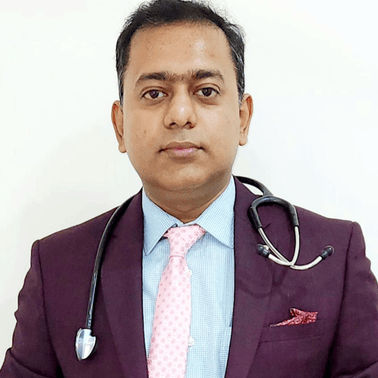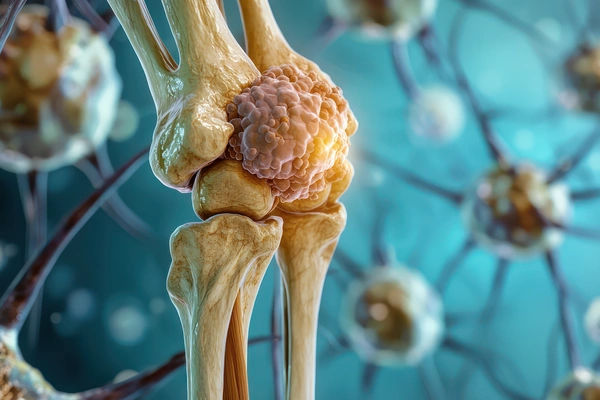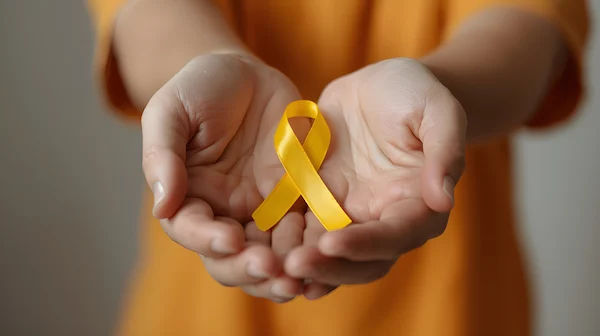Ever Heard of Sarcoma? A Guide to This Rare Cancer
Learn about sarcoma, a rare cancer of connective tissues, including symptoms, risk factors, diagnosis, and treatment options.


Introduction
You’re likely familiar with cancers like breast, lung, or prostate cancer. But have you ever heard of sarcoma? If not, you're not alone. Sarcoma is a rare and often misunderstood type of cancer that arises from connective tissues in the body—the bones, muscles, fat, nerves, cartilage, and blood vessels. Because it can develop anywhere, its symptoms are often vague and easily mistaken for more common, benign issues. This lack of awareness can lead to critical delays in diagnosis.
This guide aims to demystify sarcoma. We will walk you through what it is, how to recognise its potential warning signs, and what steps to take if you have a concern. Understanding this rare disease is the first step towards empowering yourself and others. Knowledge can be a powerful tool in spotting the unusual and advocating for timely, specialised medical care. Let's dive into the essential facts about this complex group of cancers.
What Exactly is Sarcoma? Beyond the Common Cancers
Sarcoma is fundamentally different from the carcinomas that make up the majority of cancer diagnoses. While carcinomas originate in the epithelial cells that line our organs (like the skin, lungs, or colon), sarcomas begin in the body's "supporting structures." Think of it as the difference between the bricks of a house (carcinoma) and the mortar and framework that hold it together (sarcoma). This distinction is crucial because it influences where sarcomas appear, how they behave, and how they are treated.
There are more than 70 subtypes of sarcoma, but they are broadly categorised into two main families, which helps oncologists determine the best course of action.
Sarcoma vs. Carcinoma: Understanding the Difference
The primary difference lies in the tissue of origin. Carcinomas are far more common, accounting for about 80-90% of all adult cancers. They typically form recognisable tumours in specific organs. Sarcomas, on the other hand, account for only about 1% of all adult cancers and 15% of childhood cancers, making them a "rare" disease. They can appear anywhere in the body, often in the arms, legs, or torso, but also in the abdomen or retroperitoneum (the space behind the abdominal cavity). This rarity is why many general practitioners may see only a handful of cases in their entire careers.
The Two Main Families: Bone Sarcoma and Soft Tissue Sarcoma
Bone Sarcoma
This type originates in the bones. The most common forms include Osteosarcoma (often in the long bones around the knee), Ewing Sarcoma (which can start in bones or soft tissues, common in children and young adults), and Chondrosarcoma (cancer of cartilage cells).
Soft Tissue Sarcoma (STS)
This is a larger group that can develop in muscles, fat, blood vessels, nerves, and tendons. Common subtypes include Liposarcoma (fat tissue), Leiomyosarcoma (smooth muscle, often in the uterus or abdomen), and Undifferentiated Pleomorphic Sarcoma (UPS). There are over 50 subtypes of STS, each with unique characteristics.
Consult an Oncologist for the best advice
Recognising the Signs: Symptoms of Sarcoma You Shouldn't Ignore
Early detection of sarcoma is challenging because the initial symptoms of soft tissue sarcoma can be subtle. However, paying attention to certain changes in your body can make all the difference. The most important rule is to investigate any new, unexplained lump or persistent pain.
The Tell-Tale Lump: Characteristics to Watch For
Not every lump is a sarcoma; most are benign lipomas (fatty tumours). However, certain features should raise a red flag and warrant a doctor's visit. Be concerned about a lump that is:
- Growing: Increasing in size over weeks or months.
- Large: Bigger than a golf ball (around 5 cm or 2 inches).
- Deep-seated: Feels like it's deep under the skin or within the muscle.
- Firm or Fixed: Hard to the touch and doesn't move easily when you push it.
- A lump with any of these characteristics needs evaluation, even if it's not painful.
When Pain is a Signal: Bone Sarcoma Symptoms
Bone cancer in adults and children often presents differently from soft tissue sarcoma. The most common symptom is pain in the affected bone. This pain may:
- Start as a dull ache that comes and goes.
- Progress to a constant, severe pain that is often worse at night.
- Not be relieved by over-the-counter pain medication.
Other signs can include swelling around the bone, unexplained limping, or even a pathological fracture (a bone that breaks from a minor injury because it has been weakened by cancer).
Who is at Risk? Unpacking the Causes and Risk Factors
For the vast majority of sarcoma cases, there is no clear cause. The cancer develops due to random genetic mutations in the connective tissue cells. However, researchers have identified several factors that can increase a person's risk.
Genetic Predispositions and Syndromes
Certain inherited genetic conditions significantly elevate the risk. These include:
- Li-Fraumeni Syndrome: A rare disorder that makes individuals susceptible to several cancers, including sarcoma.
- Neurofibromatosis Type 1 (NF1): Increases the risk of nerve sheath tumours called malignant peripheral nerve sheath tumours (MPNST).
- Retinoblastoma: A childhood eye cancer; survivors have a higher risk of developing bone sarcoma later in life.
Environmental and Medical Risk Factors
- Radiation Exposure: Previous radiation therapy for another cancer is a known risk factor for sarcoma developing in the treated area, though this is rare.
- Chronic Lymphoedema: Long-term swelling in an arm or leg, sometimes after lymph node surgery, can increase the risk of a subtype called lymphangiosarcoma.
- Exposure to Certain Chemicals: Industrial chemicals like vinyl chloride (used in plastics) and dioxin have been linked to an increased risk of liver sarcoma, though this is extremely uncommon.
It's critical to remember that most people with these risk factors will never develop sarcoma, and most people who do develop sarcoma have no known risk factors.
How is Sarcoma Diagnosed? The Path to a Definitive Answer
If a doctor suspects sarcoma, the diagnostic process is meticulous. Given its rarity, getting an accurate diagnosis often requires a specialist. How to diagnose a suspicious lump involves a multi-step process.
The Crucial Role of Imaging: MRI, CT, and PET Scans
Imaging helps visualise the tumour's size, location, and relationship to surrounding structures.
- MRI (Magnetic Resonance Imaging): This is the preferred imaging tool for soft tissue sarcomas of the arms and legs, as it provides excellent detail of soft tissues.
- CT (Computed Tomography) Scan: Often used for sarcomas in the chest, abdomen, or pelvis. It's also used to check if the cancer has spread (metastasised) to the lungs, a common site for sarcoma metastasis.
- PET Scan: This can help determine the metabolic activity of the tumour and is useful for staging the cancer and assessing response to treatment.
The Biopsy: The Only Way to Confirm Sarcoma
While imaging is suggestive, a tumour biopsy is the only definitive way to diagnose sarcoma. A specialist, often a surgeon or an interventional radiologist, will remove a small sample of tissue from the tumour. This sample is then analysed by a pathologist who specialises in sarcoma. They can identify the specific cell type and grade the tumour (how aggressive it appears under a microscope). This information is vital for planning the correct treatment for soft tissue sarcoma or bone sarcoma. If you have a suspicious mass, consulting a specialist who can refer you for the appropriate biopsy technique is crucial. For a comprehensive evaluation, you can book a physical visit to a specialist with Apollo24|7 to discuss your symptoms and next steps.
Treatment Options for Sarcoma: A Multidisciplinary Approach
Treatment for soft tissue sarcoma and bone sarcoma is complex and should be managed by a multidisciplinary team at a specialised cancer centre. This team includes surgical oncologists, medical oncologists, radiation oncologists, pathologists, and radiologists all working together.
Surgery: The Primary Line of Defence
The goal of surgery is to remove the entire tumour with a wide margin of healthy tissue around it to ensure no cancer cells are left behind. Historically, this often meant amputation for limb sarcomas. Today, thanks to advanced techniques, limb salvage surgery is possible in over 90% of cases, preserving both the limb and its function.
Radiation Therapy and Chemotherapy
- Radiation Therapy: Often used before surgery (neoadjuvant) to shrink the tumour or after surgery (adjuvant) to kill any remaining microscopic cancer cells. This helps reduce the risk of the cancer returning in the same spot (local recurrence).
- Chemotherapy: Its role depends on the type and stage of sarcoma. It is more commonly used for bone sarcomas like osteosarcoma and Ewing sarcoma, and for certain high-risk or metastatic soft tissue sarcomas.
Targeted Therapy and Immunotherapy: The New Frontier
For specific sarcoma subtypes, treatments that target specific genetic mutations within the cancer cells are available. For example, gastrointestinal stromal tumours (GIST), a type of sarcoma, are highly responsive to targeted drugs. Immunotherapy, which helps the body's own immune system fight cancer, is also being studied in clinical trials for various sarcomas and showing promise for certain types.
The Importance of Specialised Care: Why Expertise Matters
This point cannot be overstated. Because sarcoma is rare and has many subtypes, experience matters immensely. A specialist at a high-volume sarcoma centre is more likely to:
- Accurately diagnose the specific subtype.
- Plan the most effective surgery to minimise recurrence.
- Be aware of the latest clinical trials and targeted therapies.
Seeking care at a specialised centre can significantly impact the outcome. If your condition is complex, consulting a doctor online with Apollo24|7 can be a first step to getting a specialist referral.
Conclusion
Sarcoma may be a rare cancer, but its impact is profound. The journey often begins with a subtle sign—a lump that feels different, a pain that won't go away. The key is to listen to your body and advocate for yourself. While this guide provides essential information, it is not a substitute for professional medical advice. If you have any concerns about symptoms described here, the most important step is to speak with a healthcare provider. Early and accurate diagnosis by a specialist is the cornerstone of successful treatment for soft tissue sarcoma and bone sarcoma. By raising awareness and understanding the facts, we can help ensure that those affected by this challenging disease receive the timely, expert care they deserve. Continued support for research is also vital to developing better treatments and improving sarcoma survival rates for future generations.
Consult an Oncologist for the best advice
Consult an Oncologist for the best advice

Dr.sanchayan Mandal
Medical Oncologist
17 Years • MBBS, DrNB( MEDICAL ONCOLOGY), DNB (RADIOTHERAPY),ECMO. PDCR. ASCO
Kolkata
Dr. Sanchayan Mandal Oncology Clinic, Kolkata

Dr. Sanchayan Mandal
Medical Oncologist
17 Years • MBBS, DrNB( MEDICAL ONCOLOGY), DNB (RADIOTHERAPY),ECMO. PDCR. ASCO
Kolkata
MCR SUPER SPECIALITY POLY CLINIC & PATHOLOGY, Kolkata

Dr Sunita Samleti
Oncologist
18 Years • M.D. (Pathology)- TN Medical College, Mumbai University, Mumbai, Mar 2005 M.B.B.S. Grant Medical College, Mumbai University, Mumbai, Oct 1999
Chinagadila
Apollo Hospitals Health City Unit, Chinagadila

Dr Gowshikk Rajkumar
Oncologist
10 Years • MBBS, DMRT, DNB in Radiation oncology
Bengaluru
Apollo Clinic, JP nagar, Bengaluru

Dr. Sanchayan Mandal
Medical Oncologist
17 Years • MBBS, DNB Raditherapy, DrNB Medical Oncology
East Midnapore
VIVEKANANDA SEBA SADAN, East Midnapore
Consult an Oncologist for the best advice

Dr.sanchayan Mandal
Medical Oncologist
17 Years • MBBS, DrNB( MEDICAL ONCOLOGY), DNB (RADIOTHERAPY),ECMO. PDCR. ASCO
Kolkata
Dr. Sanchayan Mandal Oncology Clinic, Kolkata

Dr. Sanchayan Mandal
Medical Oncologist
17 Years • MBBS, DrNB( MEDICAL ONCOLOGY), DNB (RADIOTHERAPY),ECMO. PDCR. ASCO
Kolkata
MCR SUPER SPECIALITY POLY CLINIC & PATHOLOGY, Kolkata

Dr Sunita Samleti
Oncologist
18 Years • M.D. (Pathology)- TN Medical College, Mumbai University, Mumbai, Mar 2005 M.B.B.S. Grant Medical College, Mumbai University, Mumbai, Oct 1999
Chinagadila
Apollo Hospitals Health City Unit, Chinagadila

Dr Gowshikk Rajkumar
Oncologist
10 Years • MBBS, DMRT, DNB in Radiation oncology
Bengaluru
Apollo Clinic, JP nagar, Bengaluru

Dr. Sanchayan Mandal
Medical Oncologist
17 Years • MBBS, DNB Raditherapy, DrNB Medical Oncology
East Midnapore
VIVEKANANDA SEBA SADAN, East Midnapore
More articles from Sarcoma
Frequently Asked Questions
What does a sarcoma lump feel like?
A sarcoma lump is often felt as a deep-seated mass in the muscle or tissue. It is typically firm, fixed (doesn't move much), and may be painless initially. It's often described as feeling different from a soft, movable benign lipoma.
Is sarcoma curable if caught early?
Yes, when sarcoma is diagnosed at an early stage, before it has spread to other parts of the body, it is often curable with a combination of surgery, and sometimes radiation therapy. The chances of a cure are highest with complete surgical removal.
What is the survival rate for sarcoma?
Survival rates vary widely depending on the specific subtype, stage at diagnosis, location, and how well the tumour responds to treatment. For localised soft tissue sarcomas, the 5-year survival rate can be over 80%. However, for advanced or metastatic disease, the rate is lower. It's essential to discuss your individual prognosis with your oncology team.
Can sarcoma be prevented?
Since most cases have no known cause, there is no sure way to prevent sarcoma. For individuals with known genetic risk factors, regular monitoring and screening may help with early detection.
Are there stories of sarcoma survivors?
Absolutely. Many people live long, fulfilling lives after a sarcoma diagnosis. Patient advocacy groups and organisations often share powerful stories of sarcoma survivors to provide hope and support to those newly diagnosed.


